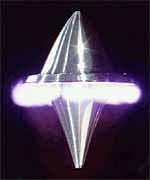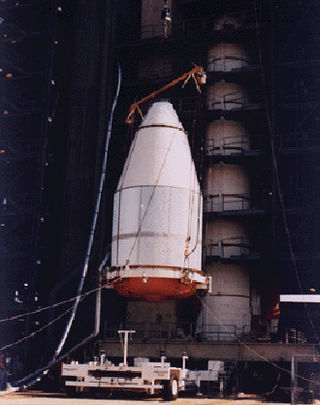
Aerodynamics is the study of the motion of air, particularly when affected by a solid object, such as an airplane wing. It involves topics covered in the field of fluid dynamics and its subfield of gas dynamics, and is an important domain of study in aeronautics. The term aerodynamics is often used synonymously with gas dynamics, the difference being that "gas dynamics" applies to the study of the motion of all gases, and is not limited to air. The formal study of aerodynamics began in the modern sense in the eighteenth century, although observations of fundamental concepts such as aerodynamic drag were recorded much earlier. Most of the early efforts in aerodynamics were directed toward achieving heavier-than-air flight, which was first demonstrated by Otto Lilienthal in 1891. Since then, the use of aerodynamics through mathematical analysis, empirical approximations, wind tunnel experimentation, and computer simulations has formed a rational basis for the development of heavier-than-air flight and a number of other technologies. Recent work in aerodynamics has focused on issues related to compressible flow, turbulence, and boundary layers and has become increasingly computational in nature.

A ramjet is a form of airbreathing jet engine that requires forward motion of the engine to provide air for combustion. Ramjets work most efficiently at supersonic speeds around Mach 3 and can operate up to Mach 6.

Atmospheric entry is the movement of an object from outer space into and through the gases of an atmosphere of a planet, dwarf planet, or natural satellite. There are two main types of atmospheric entry: uncontrolled entry, such as the entry of astronomical objects, space debris, or bolides; and controlled entry of a spacecraft capable of being navigated or following a predetermined course. Technologies and procedures allowing the controlled atmospheric entry, descent, and landing of spacecraft are collectively termed as EDL.
The plug nozzle is a type of nozzle which includes a centerbody or plug around which the working fluid flows. Plug nozzles have applications in aircraft, rockets, and numerous other fluid flow devices.

Flight or flying is the process by which an object moves through a space without contacting any planetary surface, either within an atmosphere or through the vacuum of outer space. This can be achieved by generating aerodynamic lift associated with gliding or propulsive thrust, aerostatically using buoyancy, or by ballistic movement.

A waverider is a hypersonic aircraft design that improves its supersonic lift-to-drag ratio by using the shock waves being generated by its own flight as a lifting surface, a phenomenon known as compression lift.

The Lightcraft is a space- or air-vehicle driven by beam-powered propulsion, the energy source powering the craft being external. It was conceptualized by aerospace engineering professor Leik Myrabo at Rensselaer Polytechnic Institute in 1976, who developed the concept further with working prototypes, funded in the 1980s by the Strategic Defense Initiative organization, and the decade after by the Advanced Concept Division of the US Air Force AFRL, NASA's MFSC and the Lawrence Livermore National Laboratory.

The NASA X-43 was an experimental unmanned hypersonic aircraft with multiple planned scale variations meant to test various aspects of hypersonic flight. It was part of the X-plane series and specifically of NASA's Hyper-X program developed in the late 1990s. It set several airspeed records for jet aircraft. The X-43 is the fastest jet-powered aircraft on record at approximately Mach 9.6.

Inlet cones are a component of some supersonic aircraft and missiles. They are primarily used on ramjets, such as the D-21 Tagboard and Lockheed X-7. Some turbojet aircraft including the Su-7, MiG-21, English Electric Lightning, and SR-71 also use an inlet cone.

The 9K38 Igla is a Russian/Soviet man-portable infrared homing surface-to-air missile (SAM) system. A simplified, earlier version is known as the 9K310 Igla-1, and the latest variant is the 9K338 Igla-S.
Aerodynamic heating is the heating of a solid body produced by its high-speed passage through air. In science and engineering, an understanding of aerodynamic heating is necessary for predicting the behaviour of meteoroids which enter the Earth's atmosphere, to ensure spacecraft safely survive atmospheric reentry, and for the design of high-speed aircraft and missiles.

A nose cone is the conically shaped forwardmost section of a rocket, guided missile or aircraft, designed to modulate oncoming airflow behaviors and minimize aerodynamic drag. Nose cones are also designed for submerged watercraft such as submarines, submersibles and torpedoes, and in high-speed land vehicles such as rocket cars and velomobiles.

Aerocapture is an orbital transfer maneuver in which a spacecraft uses aerodynamic drag force from a single pass through a planetary atmosphere to decelerate and achieve orbit insertion.
This is an alphabetical list of articles pertaining specifically to aerospace engineering. For a broad overview of engineering, see List of engineering topics. For biographies, see List of engineers.
Scramjet programs refers to research and testing programs for the development of supersonic combustion ramjets, known as scramjets. This list provides a short overview of national and international collaborations, and civilian and military programs. The USA, Russia, India, and China (2014), have succeeded at developing scramjet technologies.

Harry Julian Allen, also known as Harvey Allen, was an aeronautical engineer and a Director of the NASA Ames Research Center, most noted for his "Blunt Body" theory of atmospheric entry which permitted successful recovery of orbiting spacecraft. His technique is still used to this day.

An aeroshell is a rigid heat-shielded shell that helps decelerate and protects a spacecraft vehicle from pressure, heat, and possible debris created by drag during atmospheric entry. Its main components consist of a heat shield and a back shell. The heat shield absorbs heat caused by air compression in front of the spacecraft during its atmospheric entry. The back shell carries the load being delivered, along with important components such as a parachute, rocket engines, and monitoring electronics like an inertial measurement unit that monitors the orientation of the shell during parachute-slowed descent.

In naval architecture and aerospace engineering, the fineness ratio is the ratio of the length of a body to its maximum width. Shapes that are short and wide have a low fineness ratio, those that are long and narrow have high fineness ratios. Aircraft that spend time at supersonic speeds, e.g. the Concorde, generally have high fineness ratios.

The Ayaks is a hypersonic waverider aircraft program started in the Soviet Union and currently under development by the Hypersonic Systems Research Institute (HSRI) of Leninets Holding Company in Saint Petersburg, Russia.
Space Engine Systems Inc. (SES) is a Canadian aerospace company and is located in Edmonton, Alberta, Canada. The main focus of the company is the development of a light multi-fuel propulsion system to power a reusable spaceplane and hypersonic cruise vehicle. Pumps, compressors, gear boxes, and other related technologies being developed are integrated into SES's major R&D projects. SES has collaborated with the University of Calgary to study and develop technologies in key technical areas of nanotechnology and high-speed aerodynamics.















